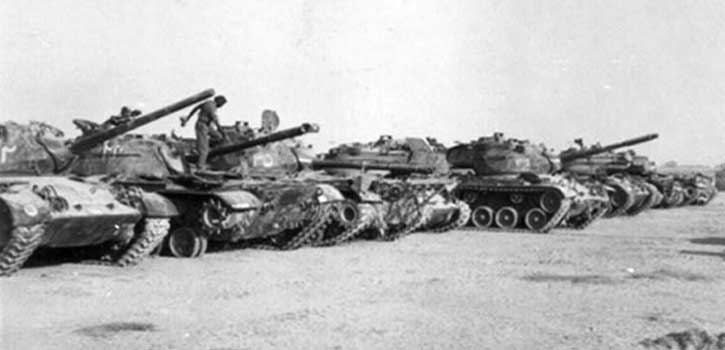Indo-Pakistan War of 1965

The second Indo-Pakistani conflict (1965) was also fought over Kashmir and started without a formal declaration of war. The war began in August 5, 1965 and was ended Sept 22, 1965.
The war was initiated by Pakistan who since the defeat of India by China in 1962 had come to believe that Indian military would be unable or unwilling to defend against a quick military campaign in Kashmir, and because the Pakistani government was becoming increasingly alarmed by Indian efforts to integrate Kashmir within India. There was also a perception that there was widespread popular support within for Pakistani rule and that the Kashmiri people were disatisfied with Indian rule.
After Pakistan was successful in the Rann of Kutch earlier in 1965, Ayub Khan (by nature a cautious person) was pressured by the hawks in his cabinet (led by Z.A. Bhutto) and the army to infiltrate the ceasefire line in Kashmir. The action was based on the incorrect premise that indigenous resistance could be ignited by a few saboteurs. Ayub resisted the idea as he foresaw India crossing the international frontier in retaliation at a point of its choosing. The Bhutto faction, which included some prominent generals, put out the canard that Ayub's cowardice stemmed from his desire to protect his newly acquired wealth. It was boasted at the time that one Pakistani soldier was equal to four Indian soldiers and so on.
On August 5, 1965 between 26,000 and 33,000 Pakistani soldiers crossed the Line of Control dressed as Kashmiri locals headed for various areas within Kashmir. Indian forces, tipped off by the local populace, crossed the cease fire line on August 15.
The initial battles between India and Pakistan were contained within Kashmir involving both infantry and armor units with each country's air force playing major roles. It was not until early Sept. when Pakistani forces attacked Ackhnur that the Indians escalated the conflict by attacking targets within Pakistan itself, forcing the Pakistani forces to disengage from Ackhnur to counter Indian attacks.
The largest engagement of the war occurred in the Sialkot region where some 400 to 600 tanks squared off. Unfortunately the battle was indecisive.
By Sept 22 both sides had agreed to a UN mandated cease-fire ending the war that had by that point reached a stalemate.
Overall, the war was militarily inconclusive; each side held prisoners and some territory belonging to the other. Losses were relatively heavy--on the Pakistani side, twenty aircraft, 200 tanks, and 3,800 troops. Pakistan's army had been able to withstand Indian pressure, but a continuation of the fighting would only have led to further losses and ultimate defeat for Pakistan. Most Pakistanis, schooled in the belief of their own martial prowess, refused to accept the possibility of their country's military defeat by "Hindu India" and were, instead, quick to blame their failure to attain their military aims on what they considered to be the ineptitude of Ayub Khan and his government.
Pakistan was rudely shocked by the reaction of the United States to the war. Judging the matter to be largely Pakistan s fault, the United States not only refused to come to Pakistan s aid under the terms of the Agreement of Cooperation, but issued a statement declaring its neutrality while also cutting off military supplies. The Pakistanis were embittered at what they considered a friend's betrayal, and the experience taught them to avoid relying on any single source of support. For its part, the United States was disillusioned by a war in which both sides used United States-supplied equipment. The war brought other repercussions for the security relationship as well. The United States withdrew its military assistance advisory group in July 1967. In response to these events, Pakistan declined to renew the lease on the Peshawar military facility, which ended in 1969. Eventually, United States-Pakistan relations grew measurably weaker as the United States became more deeply involved in Vietnam and as its broader interest in the security of South Asia waned.
Iran, Indonesia, and especially China gave political support to Pakistan during the war, thus suggesting new directions in Pakistan that might translate into support for its security concerns. Most striking was the attitude of the Soviet Union. Its post-Khrushchev leadership, rather than rallying reflexively to India's side, adopted a neutral position and ultimately provided the good offices at Tashkent, which led to the January 1966 Tashkent Declaration that restored the status quo ante.
The aftermath of the 1965 war saw a dramatic shift in Pakistan's security environment. Instead of a single alignment with the United States against China and the Soviet Union, Pakistan found itself cut off from United States military support, on increasingly warm terms with China, and treated equitably by the Soviet Union. Unchanged was the enmity with which India and Pakistan regarded each other over Kashmir. The result was the elaboration of a new security approach, called by Ayub Khan the "triangular tightrope"--a tricky endeavor to maintain good ties with the United States while cultivating China and the Soviet Union. Support from other developing nations was also welcome. None of the new relationships carried the weight of previous ties with the United States, but, taken together, they at least provided Pakistan with a political counterbalance to India.



